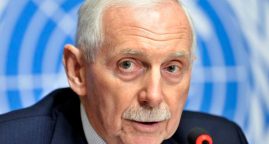The Practical Guide to Humanitarian Law
Article published on MSF website on April 2017
The Practical Guide to Humanitarian Law was published for the first time by Françoise Bouchet-Saulnier in 1998. Regularly reedited and translated in several languages, the latest edition was published in December 2013 and makes up the content of this website.
Written from the perspective of victims and those who provide assistance to them, the Practical Guide presents the rules of humanitarian law applicable to the protection and assistance of victims of conflicts and crisis in accessible and reader-friendly alphabetical entries.
It analyzes how international humanitarian law has evolved in the face of new challenges to international peace and human security related to the war on terror, new forms of armed conflict and humanitarian action, the emergence of international criminal justice, and the reshaping of fundamental rules in a multipolar world.
An unprecedented work, intended for journalists and citizens, policy makers and opinion leaders, relief workers, members of humanitarian organizations and practitioners, war leaders and servicemen…
You will find here all the entries of the Practical Guide, regularly updated. The website is intended to be simple to use, interactive and didactic. In order to provide intuitive navigation, each entry is integrated into a broader category, a search engine is available and you will also find an index of convention and ratifications.
“This book is thus written for those who analyze events that take place in the world and those who seek to understand them, those who inquire about the choice and innocence of words stemming from new forms of political and military propaganda.
It is written for those who seek to defend humanitarian space in situations in which the lives of the most vulnerable are threatened by direct or indirect violence and abandonment by governments.
It is written for practitioners who must mediate unequal power relationships among States, armies, victims, international organizations, and nongovernmental groups.
Lastly, it is written for each of us, potential victims of violence and armed conflict, to help us resist and survive crimes against humanity and allow the emerging global society to be more humane.”
Françoise Bouchet-Saulnier
Protecting Powers
To ensure the protection of the general population in times of conflict, humanitarian law establishes a system of protecting powers, meant to safeguard the interests of the persons protected by the Geneva Conventions and their Protocols (GCI–III Arts. 8–11; GCIV Arts. 9–12; API Art. 5).
Function and Mandate of the Protecting Powers
Function
This system was set up to enable the adverse parties to a conflict to maintain a dialogue concerning the protection of their populations.
The Conventions provide that, from the beginning of a conflict, each party has the obligation to appoint a protecting power to ensure the implementation of the Geneva Conventions and their Additional Protocols. The delegates of the appointed protecting powers are subject to the approval of the adverse party with which they are to carry out their duties.
Mandate
The protecting powers’ mandate is to monitor and safeguard the interests of the parties to the conflict and their nationals. To this end, they enjoy certain specific rights and duties (GCIV Arts. 30, 143):
- the right to visit persons protected by the Geneva Conventions and their Additional Protocols;
- the right to evaluate their living conditions in cases of detention or in occupied territories;
- the right to supervise the distribution of relief supplies;
- the duty to ensure that relief operations are of a civilian and impartial nature and to prevent this relief from being diverted for military purposes;
- the right to supervise the concrete implementation of protective measures for protected persons, especially in cases of detention, internment, and occupied territory;
- the right to ensure that judicial guarantees are respected, in case of a trial, especially in cases possibly involving the death penalty;
- protected persons have the right to refer their cases to protecting powers.
Who May Take on the Responsibilities of the Protecting Power?
States
In theory, protecting powers are representatives of States that are not involved in the conflict at hand and that accept to verify that humanitarian law is being respected on the territory of a given party to the conflict. In practice, since the Geneva Conventions were adopted in 1949, no State has ever accepted this role for any of the conflicts that have taken place. Through this refusal, States show their lack of concrete commitment to actually defending the implementation of humanitarian law. The Geneva Conventions had foreseen this diplomatic weakness and set up several provisions for substitution mechanisms. The ICRC is formally under the obligation to offer its good offices so as to facilitate the designation of such protecting powers.
Substitute Protecting Powers: The ICRC and Humanitarian Organizations
The ICRC mediation role is firmly established in the Conventions. It must ask each party to a conflict to provide it with a list of at least five States that it would consider acceptable as a protecting power in relation to an adverse party (GCI–III Art. 8, GCIV Art. 9, and API Art. 5).
If, despite this intervention, the parties to the conflict still do not succeed in designating a protecting power, the Conventions establish that the ICRC will act as substitute protecting power and take on its functions. Other impartial humanitarian organizations also have the possibility of taking on the role of protecting power if the relevant parties accept their offer of services.
In such cases, the substitutes are no longer States but organizations, presenting all guarantees of impartiality and effectiveness. After they have been accepted by the parties to the conflict, these organizations can take on the functions of the protecting powers: monitoring the application and defense of the rights and obligations set forth in the Geneva Conventions for protected persons (GCI–III Art. 11, GCIV Art. 12, and API Art. 5).
It is important to note that this system of substitution is subject to the reciprocal consent of the parties to the conflict, and therefore can fail. In such cases, the Geneva Conventions impose the presence and activities of the ICRC (GCIV Arts. 30, 143).
If the parties to a conflict fail to designate a protecting power or substitute of their own accord, they are nonetheless under the obligation to:
- request that an organization such as the ICRC take on the humanitarian functions meant to be performed by protecting powers under the Geneva Conventions and accept offers of services of such an organization.
In practice, this role—which is central to the proper implementation of the Geneva Conventions—is fulfilled almost exclusively by the ICRC.
The provisions concerning a protecting power or substitute create a space for humanitarian protection that can be filled by international and nongovernmental organizations present in situations of conflict (GCI–III Art. 10, GCIV Art. 11, and API Art. 5.4).
Related Articles
‘Migrant crisis challenges Christian unity’, says bishop
11/29/2016. The migrant crisis has undermined harmony within churches in Europe, a Catholic bishop has told a high-level EU summit.
Vatican official: Europe not immune to anti-Christian discrimination
03/31/2017.Archbishop Paul Richard Gallagher called on an “institutionalized dialogue” at all levels between civil authorities and religious groups to help foster religious liberty.
IOM DG Swing’s Statement at the Syria Brussels Conference
04/05/2017. “The future of Syria will be grim if current needs are not being addressed with a greater sense of urgency.”






